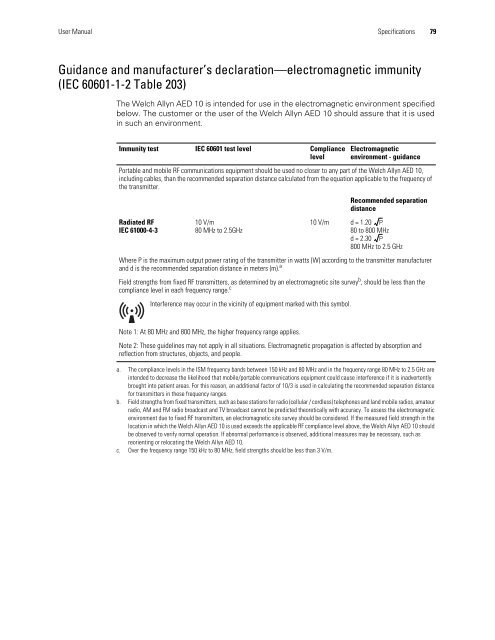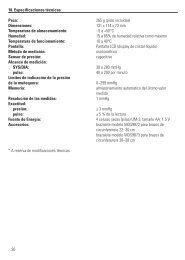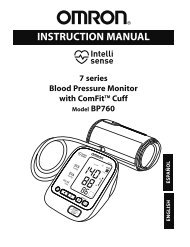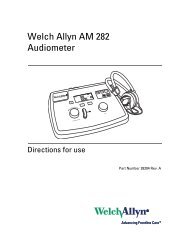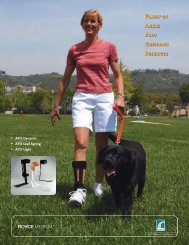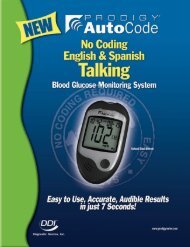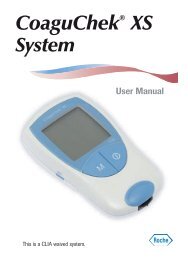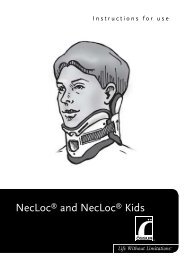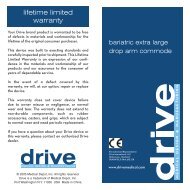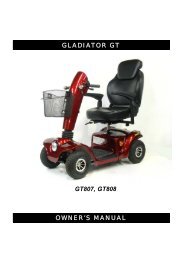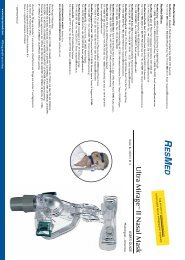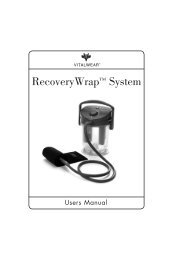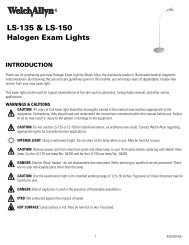AED 10 User Manual - Welch Allyn
AED 10 User Manual - Welch Allyn
AED 10 User Manual - Welch Allyn
Create successful ePaper yourself
Turn your PDF publications into a flip-book with our unique Google optimized e-Paper software.
<strong>User</strong> <strong>Manual</strong> Specifications 79Guidance and manufacturer’s declaration—electromagnetic immunity(IEC 60601-1-2 Table 203)The <strong>Welch</strong> <strong>Allyn</strong> <strong>AED</strong> <strong>10</strong> is intended for use in the electromagnetic environment specifiedbelow. The customer or the user of the <strong>Welch</strong> <strong>Allyn</strong> <strong>AED</strong> <strong>10</strong> should assure that it is usedin such an environment.Immunity test IEC 60601 test level CompliancelevelElectromagneticenvironment - guidancePortable and mobile RF communications equipment should be used no closer to any part of the <strong>Welch</strong> <strong>Allyn</strong> <strong>AED</strong> <strong>10</strong>,including cables, than the recommended separation distance calculated from the equation applicable to the frequency ofthe transmitter.Radiated RFIEC 6<strong>10</strong>00-4-3<strong>10</strong> V/m80 MHz to 2.5GHzRecommended separationdistance<strong>10</strong> V/m d = 1.20 P80 to 800 MHzd = 2.30 P800 MHz to 2.5 GHzWhere P is the maximum output power rating of the transmitter in watts (W) according to the transmitter manufacturerand d is the recommended separation distance in meters (m). aField strengths from fixed RF transmitters, as determined by an electromagnetic site survey b , should be less than thecompliance level in each frequency range. cInterference may occur in the vicinity of equipment marked with this symbol.Note 1: At 80 MHz and 800 MHz, the higher frequency range applies.Note 2: These guidelines may not apply in all situations. Electromagnetic propagation is affected by absorption andreflection from structures, objects, and people.a. The compliance levels in the ISM frequency bands between 150 kHz and 80 MHz and in the frequency range 80 MHz to 2.5 GHz areintended to decrease the likelihood that mobile/portable communications equipment could cause interference if it is inadvertentlybrought into patient areas. For this reason, an additional factor of <strong>10</strong>/3 is used in calculating the recommended separation distancefor transmitters in these frequency ranges.b. Field strengths from fixed transmitters, such as base stations for radio (cellular / cordless) telephones and land mobile radios, amateurradio, AM and FM radio broadcast and TV broadcast cannot be predicted theoretically with accuracy. To assess the electromagneticenvironment due to fixed RF transmitters, an electromagnetic site survey should be considered. If the measured field strength in thelocation in which the <strong>Welch</strong> <strong>Allyn</strong> <strong>AED</strong> <strong>10</strong> is used exceeds the applicable RF compliance level above, the <strong>Welch</strong> <strong>Allyn</strong> <strong>AED</strong> <strong>10</strong> shouldbe observed to verify normal operation. If abnormal performance is observed, additional measures may be necessary, such asreorienting or relocating the <strong>Welch</strong> <strong>Allyn</strong> <strong>AED</strong> <strong>10</strong>.c. Over the frequency range 150 kHz to 80 MHz, field strengths should be less than 3 V/m.


